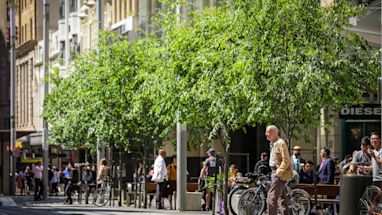In the first trial of its kind, we’ve taken industrial waste from coal-fired power stations and steel manufacturing to create a new roadway.
Working with researchers from the University of NSW, we’ve replaced a section of roadway on Wyndham Street in Alexandria to test the green concrete’s durability.
Made from fly ash and blast furnace slag, geopolymer concrete is a sustainable blend of concrete and recycled materials.
Embedded content: https://youtu.be/_GW2iL3YRxw
Geopolymer generates just 300kgs of CO2 per tonne of cement, compared to 900kgs from traditional cement production. The carbon emissions savings is equivalent to the electricity used by an average household every 2 weeks.
With 70% of the concrete produced today going into pavements and footpaths, using products like geopolymer concrete for our roads and footpaths has great potential to further lower emissions from our operations.
As a major road leading to Sydney Airport, Wyndham Street’s high traffic volume provides the perfect conditions for the trial.

9 sensors have been positioned under the concrete to monitor and compare how the geopolymer concrete performs.
University of NSW researchers and the Cooperative Research Centre for Low Carbon Living will use results from the trial to create the first set of industry guidelines for geopolymer concrete.
Research has been undertaken since the 1990s, but it’s only now this concrete blend is being explored as a product that is not only better for the environment, but also commercially viable.

The low CO2 concrete has the potential to put the 400 million cubic tonnes of globally documented waste from the coal and steel industries to good use. While a small amount is currently used in construction, much of it is currently stored on site.
University of NSW researchers will monitor the road performance for up to 5 years.

Professor Stephen Foster, head of school of civil and environmental engineering, is the project lead. He describes the trial as “a huge step forward”.
“This trial will help drive step change in the industry. Many concrete companies are already doing a lot to change, but this trial really gives it another push,” Stephen said.

“While we’ll monitor the road performance for up to 5 years, a lot of the data collected in the first 3 to 12 months of this world-first trial will be used to confirm our models and strengthen our predictions.

“Concrete contributes 7% of all greenhouse gas emissions and in 2018 the world produced about 4.1 billion tonnes of cement, which contributed about 3.5 billion tonnes of CO2.
“Alternative, low CO2 concrete materials offer potential benefits in reducing the greenhouse gas emissions associated with conventional concrete.
“This trial is important because we need demonstration projects to accurately assess the performance of geopolymer over time so that there can be broader uptake," he said.
Published 17 June 2019, updated 19 October 2023



